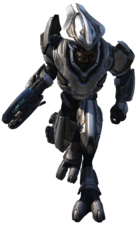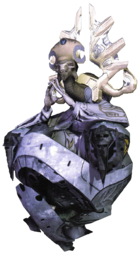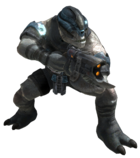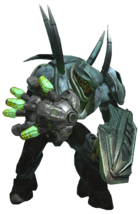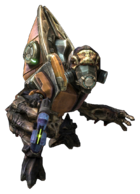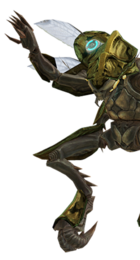Covenant: Difference between revisions
From Halopedia, the Halo wiki
m (Not notable - the idea of the Covenant predate Universe at War. if we're going to list groups that resemble the Covenant, we're going to be here a long time.) |
|||
| Line 135: | Line 135: | ||
===Kig-Yar=== | ===Kig-Yar=== | ||
{{main|Kig-yar}} | {{main|Kig-yar}} | ||
The Kig-Yar, or Jackals or Skirmishers as they are known by humans,<ref name="flood"/> were the scouts and marksmen of the Covenant military due to their superior senses. They were the second lowest Covenant caste and are about 5'6" tall. | The Kig-Yar, or Jackals or Skirmishers as they are known by humans,<ref name="flood"/> were the scouts and marksmen of the Covenant military due to their superior senses. They were the second lowest Covenant caste and are about 5'6" tall.Due to their weak bodies, most of them carry [[Kig-Yar point defense gauntlets]] | ||
|- | |- | ||
|[[File:HaloReach - Drone.png|140px|right|link=Yanme'e]] | |[[File:HaloReach - Drone.png|140px|right|link=Yanme'e]] | ||
===Yanme'e=== | ===Yanme'e=== | ||
{{main|Yanme'e}} | {{main|Yanme'e}} | ||
Revision as of 15:03, July 14, 2011
- Covenant redirects here. For more articles of the same name, see Covenant (disambiguation).
| The Covenant | |
|---|---|
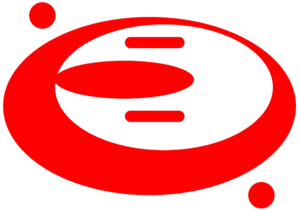
| |
| Government overview | |
|
Type: |
Theocratic cultural hegemony |
|
Executive branch: |
|
|
Legislative branch: |
|
|
Judicial branch: |
|
| Societal overview | |
|
Official language(s): |
Sangheili language serves as lingua franca; various languages spoken by different races.[1] |
| Historical overview | |
|
Formation: |
Founded at the end of the Sangheili-San'Shyuum War |
|
Fragmentation: |
|
|
Dissolution: |
Battle of Installation 00 |
- "Creatures of the Covenant, the path is broad, and we shall walk it side by side."
- — The Prophet of Truth[2]
The Covenant, also referred to as the Covenant Empire was a religious hegemony of multiple alien species that controlled a large portion of the Orion Arm in the Milky Way Galaxy. Originally a mutual alliance between the San 'Shyuum and the Sangheili, the Covenant expanded to include at least six other races united in the worship of the Forerunners and the Halo Array. They waged a genocidal campaign against Humanity until they were defeated due to many factors, the most crucial of which was an internal conflict. While the Covenant's leadership was either lost during the Flood infection of High Charity or during the Battle of Installation 00, the Covenant continues to exist even after the conclusion of the war.[3] In exactly what capacity it continues to operate remains unknown.
History
- Main article: History of the Covenant
- "The First Age: Ignorance and Fear.
- The Second Age: Rivalry and Bloodshed.
- The Third Age: Humility and Brotherhood.
- The Fourth Age: Wonder and Understanding.
- The Fifth Age: Obedience and Freedom.
- The Sixth Age: Faith and Patience.
- The Seventh Age: Journey and Salvation.''"
- The Sixth Age: Faith and Patience.
- The Fifth Age: Obedience and Freedom.
- The Fourth Age: Wonder and Understanding.
- The Third Age: Humility and Brotherhood.
- The Second Age: Rivalry and Bloodshed.
- — Maccabeus and the Jiralhanae of the Rapid Conversion.[4]
The Covenant created its own means of connoting time, comprised of "Ages." The Covenant's history is broken up into multiple occurrences of seven types of Age, each representing the predominant theme that occurred during those periods of time. These ages do not necessarily follow one another in order, nor are they equal in quantity. As an example, there were significantly more Ages of Conflict and Doubt than Reclamation. Each Age is further broken into what is called Cycles. A Cycle is the Covenant version of a day and it represents one artificial day on High Charity. A Cycle contains approximately 265 units, which if translated into human time is one hour of time on Earth.[5]
In 938 BCE,[6] the San'Shyuum Reformists entered a Sangheili-occupied system that lead to first contact between the San'Shyuum and the Sangheili. The San'Shyuum, who came to Sangheilios in order to claim and study the rich abundance of Forerunner artifacts left behind,[7] soon found themselves sharing different ideologies of how such relics should be treated, which quickly devolved into conflict between the San'Shyuum and the Sangheili.
The Sangheili believed that Forerunner relics were sacred and should not be touched, while the San'Shyuum Reformists believed that they should be studied and use them to make practical objects of their own design.[8] The highly-militarized Sangheili attacked the San 'Shyuum almost as soon as their differences became apparent,[9] and a war between the two species raged for eighty six years.[6]
At the start of the war, the Sangheili had a numerical advantage in terms of ships and soldiers, their strength and military tactics overwhelmed their enemy by a considerable factor. The San'Shyuum's knowledge, gleaned from years of travel and the capabilities of their Forerunner Dreadnought, however gave them the advantage in ship-to-ship combat, the most common type of combat witnessed during the war.[9]
Eventually both species came to fear a very real threat: Annihilation. The Sangheili who feared it through the San'Shyuum's use of the Dreadnought; and the San'Shyuum who came to admit that if the Sangheili were this dangerous, there might be other sentient life far more threatening, making their chances of survival in the galaxy slim.[9] The long and brutal war caused the Sangheili to violate their very beliefs, study and incorporate Forerunner technology into their own in order to avoid defeat[9] — their incorporation of Forerunner technology eventually caused a stalemate in the war against the San'Shyuum,[9] their Dreadnought however proved far too effective and forced the Sangheili to surrender.[7]
In their warrior culture, the Sangheili have great respect for a worthy adversary, and after their surrender the San'Shyuum sought to seek a burgeoning Covenant of the two races, thus the term "Covenant", the alliance between the two species; was formed in 852 BCE with the signing of the Writ of Union, the treaty that ended the conflict and brought about peace between the two.[6]
The conclusion of the conflict marked the First Age of Reconciliation, followed by the First Age of Conversation, which marked the beginning expansion of the Covenant by bringing the Lekgolo into the Covenant, and throughout these Ages new races were incorporated into the Covenant. In between these ages were what became known as the Ages of Doubt, these ages signified no great discoveries were made, and members of the Covenant grappling with internecine conflict.[5]
During the 23rd Age of Doubt the Covenant encountered Humanity for the first time. This inevitable meeting would start a war that over time threw the entire foundation of the Covenant's religion and political alliance into a gradual state of disarray.[10]
During the final years of the war against humanity the remaining Prophets, led by the High Prophet of Truth, used the opportunity to replace the Sangheili with Jiralhanae as their protectors. However, this move effectively angered the Sangheili, who had been in such a position since the founding of the Covenant.
Truth gave command of the Covenant Fleets to the Jiralhanae. Once there were enough Jiralhanae in place, Truth secretly ordered them to commit a mass genocide on the Sangheili. The Jiralhanae replaced the Sangheili within the society of the Covenant. The Sangheili revolted, enlisting the help of some of the Mgalekgolo and Unggoy, beginning a destructive civil war within High Charity itself and on the surrounding Covenant fleet.
Early into the Great Schism, most of the Sangheili Councilors were assassinated by the Jiralhanae at the will of the Prophet of Truth, most likely in attempt to deprive the Sangheili of their leadership core. When the Sangheili learned the truth about the Halos, it changed the war significantly and added Humanity into the struggle. Instead of a Great Journey, the Gravemind's revelation regarding the superweapon contradicted the entire Covenant's belief system.
Though the Prophet of Truth was eventually killed, and most of the Loyalist's known fleet was destroyed by the Sangheili fleet above the Ark, the Covenant still exists in some force, though in a weakened state, forced to rebuild after the war.[3] Rtas 'Vadum expressed concern that the Sangheili homeworld, Sanghelios, may have still been endangered by the Covenant, and considering the sheer size of the former Covenant it is unlikely that the entirety of the Loyalists were present at Earth. Exactly who or what remains in charge of the political and military leadership of the Covenant is also unknown as the San'Shyuum population is only within the thousands and is near extinction.[11] They have not been sighted by the Sangheili since 2553.[12]
The devout and stubborn Jiralhanae have continued their war with the Sangheili and fight amongst themselves, effectively battling their species towards extinction.
Government
For the majority of its existence, the two ruling classes of the Covenant were the San'Shyuum and the Sangheili, though the San'Shyuum held greater sway over the Covenant due to their status as "the voice of the gods".[13] On the outbreak of the Great Schism, the Sangheili were cast out and the Jiralhanae replaced the Sangheili as the secondary ruling class. The Covenant had ten echelons of government, the highest echelon being the High Council, which was responsible for making all important decisions. Prior to the Great Schism, it was made up of 200 members of Sangheili and San'Shyuum,[14][15] and was ruled by the three San'Shyuum Hierarchs. These Hierarchs were the highest political and religious authority in the Covenant. For each new Age, three new Hierarchs were appointed; in order for them to usher in a new age and assume power, they must receive a blessing from the Oracle of High Charity.[16][15] This Oracle is a Forerunner Artificial Intelligence found within the Dreadnought which sat at the center of the capital. Until the events that led to the war against Humanity, the Oracle had not spoken for over a millennia, so the ascension of the Hierarchs is steeped with political bribes, blackmail and manipulation of the San'Shyuum Philologist.[16][17]
The High Council consisted of San'Shyuum Councilors and Sangheili Councilors, who are extremely important to the Covenant society. The High Council served as the central theocratic and decision-making body of the Covenant. In addition to the High Council, there are three other Councils: the Council of Concordance, the Council of Deed and Doctrine and the Council of Masters. Below that numerous Ministries exist within the Covenant government, each of which dictates a single, but important role within the Governmental body of the Covenant.
In truth, however, the San'Shyuum and Sangheili had an uneasy coexistence, and political infighting was very common behind the scenes. This became an all-out war during the Great Schism. Template:Covenant Government
Religion and culture
- Main article: Covenant Religion
Covenant society had a distinct caste-based societal system which has a strong theocratic underpinning.[13][18] There were three basic Covenant castes: The Religious caste, the Military or Warrior caste, and the Worker caste.
The Covenant's culture and religion was based solely on the worship and reverence of the Forerunners. Long ago, the San'Shyuum managed to decipher some of the data stored on terminals aboard the Forerunner Dreadnaught, thanks to the Forerunners' robust translation systems. However, even then they were unable to fully comprehend the subtle meanings of many Forerunner glyphs.[13] The San'Shyuum incorrectly interpreted the activation of the Halo Array as a means of transcending mortality, a process they came to call the Great Journey. They did not understand that the Array had been designed to eradicate the Flood, specifically by triggering a galactic holocaust and killing all sentient life within the galaxy. They arrived at the conclusion that the Forerunners had ascended to godhood and left other species of the galaxy to their fates.[13] Because of this, the Covenant devoted itself to searching for and recovering of Forerunner artifacts. At several points in the Covenant's history, this desire to reclaim Forerunner technology has resulted in the hegemony declaring war against non-compliant species, the most recent instance being their war against humanity. In Covenant society, personal vendettas are not tolerated,[19] although many conflicts in the Covenant's past have been sparked by vendettas.[20]
The Covenant used commerce as a form of economy. As the Covenant's cohesion was grounded in its belief of working to obtain and sharing Forerunner technology, every member of the Covenant was given a form of employment[8] or a service to fulfill in exchange for goods and necessities. In the Covenant's culture, service for salvation was the moral motivation for the entire population.[21] Despite this, there was discrimination within the Covenant: The lesser species were treated as second-class citizens with little political or representative voice or power.
The Covenant were always eager to add new species to the faith,[22] so long as they pledged allegiance to the San'Shyuum as their supreme leaders and the Great Journey as their religion.[23] Client races were in all essence enslaved by the Covenant, forced to live a completely different way of life, and if unlucky enough, had their entire culture and history erased. The client races were held together by a common belief; the slave races were driven by the religion which they had been forced to accept. Most races were only kept for their varying skills to be exploited, rather than to be a part of a flourishing empire.
Military
- Main article: Covenant Military
Like other civilizations, the Covenant maintained a permanent armed forces branch, which it used to enforce order, conduct atmospheric and space combat operations, and generally carry out the Covenant's will throughout space. The Covenant military was originally led by the Sangheili, who were replaced by the Jiralhanae during the Great Schism. The military was comprised of the Covenant Navy, the Covenant Army and the Special Warfare Group, which contained the Special Operations Division.
Most of the Covenant arsenal consists of plasma-based directed energy weapons, but the Covenant are known to also utilize pulse lasers, particle beam weapons, antimatter explosives and even chemical crystal-based weapons. Interestingly, Covenant weapon designs seem to defy known laws of mechanics; there is typically no form of radiative, physical or electrical contact between the firing mechanism and "trigger" of a weapon. For these and other reasons, the workings of Covenant weaponry is generally beyond the comprehension of UNSC scientists.
Plasma weapons typically use a rechargeable power cell to provide power to their internal components. Covenant plasma weapons are effective but crude, and most automatic-fire plasma weapons are prone to overheating. To compensate, most weapons have vents that open up and discharge excess heat and plasma when they overheat, although they render weapons inoperable as the excess heat is dissipated. Once the energy of the plasma weapon is depleted, it must be recharged or discarded. To date, the means by which plasma weapons can be recharged is still unknown to UNSC forces.
The Covenant are also known to employ projectile weapons, the most common of these being unconventional crystal-based weapons. These weapons appear to use some type of chemical that forms a hard, razor-sharp crystal on contact with the atmosphere.[24] These crystals can be used in one of two ways. Certain medium to long-range weapons fire them at high speeds, allowing them to strike targets accurately at long distance. Other mid-range weapons fire them at very slow speeds, and through unknown means "steer" them towards enemy targets. Needles fired in either of these ways will penetrate the flesh or armor of a target, and several seconds after coming to rest will explode into thousands of tiny, sharp fragments that can maim or cripple a target. When a certain number of needles have penetrated the same target, they will detonate simultaneously, producing a much larger explosion that kills the target instantly.
With the introduction of the Jiralhanae as a major military caste within the Covenant, their weapons found limited to widespread use. Utilizing crude projectile-like metal spikes in place of plasma, explosive grenade-like launchers, and sharp blades, they are more primitive, yet brutal - fitting, considering the nature of their creators.
The Covenant were also known to employ melee weapons in addition to their already fearsome arsenal. The most well-known is the Energy Sword, used solely by the Sangheili. Creating a double blade of superheated plasma, it has both ceremonial and martial value to the Sangheili warriors, and its possession is closely monitored. Another is the Gravity Hammer, used by Jiralhanae, which seems to be the cultural equivalent to the sword, However, rather than using a blade of plasma, it can generate a gravitational field, doing devastating damage.
Covenant vehicles use advanced anti-gravity technology for propulsion, and are armed with directed-energy weaponry of varying potency. Though often faster than their UNSC counterparts, Covenant vehicles are more unstable over uneven terrain where the sudden changes affect handling. All Covenant vehicles are made from a purple or dark blue type of metal, said to be much more advanced than any alloy known to Humans, and all Covenant vehicles are nicknamed after some kind of supernatural entity by the UNSC, except for Scarabs and Locusts. Recently, Brute vehicles and technology have been incorporated into the Covenant's arsenal. Though more primitive, they serve the Brutes' need for power. Brute vehicles are not named after spiritual entities, and rather than being a series of Covenant vehicles are regarded as native Jiralhanae technology.
Species
The species that make up the Covenant Empire came from different parts of the galaxy and take all kinds of physical forms. Organized into a caste system by their religious leaders the San'Shyuum, the different species of the Covenant have many divisions but there is one powerful force that once united them — their blind faith in the Great Journey.[25]
Many of the alien species conquered by the Covenant were conscripted into, or gradually become part of the alliance.[21] However, during the first contact with the Humans, The Oracle on board the Forerunner Dreadnought revealed to Truth and Regret that Humans are Reclaimers, as shown by its luminary. Since the entire Covenant was based on the belief that the Forerunners had transcended, Truth and Regret knew if any of the other races found out what the Oracle told them, the Covenant would cease to exist.[26]
Sangheili (pre-Great Schism)
The second highest caste; Sangheili, or Elites as humans call them,[27] served as the military leaders of the Covenant before the Great Schism. While San'Shyuum often had the final say, it was the Sangheili who organized military campaigns and naval engagements. The Sangheili are the only known race permitted to build and operate starships within the Covenant, though the crews are always composed of a mix of races.[28] Sangheili are separated into ranks based on skill and experience. To advance in rank, Sangheili must honorably earn such advancements on the battlefield.[29] |
San 'Shyuum
The highest caste in the Covenant Empire, the San 'Shyuum, or Prophets as humans call them, led the Covenant and exerted complete control over all religious and political affairs. Though physically weak, Prophets wielded power through absolute command of the Covenant and through scavenged Forerunner technology, leaving the task of conquest to the Sangheili and the other races. The High Prophets were addressed as "Hierarchs", "Noble Hierarchs", "Holy Ones", or "Exalted" by the other races of the Covenant. |
Jiralhanae
The Jiralhanae, or Brutes as they are known by humans,[27] were one of the newer species to the Covenant Empire and were the only race that has obtained very close to equal status to that of one of the founding "clients" of the Covenant pact, the Sangheili. The Jiralhanae took over their role as personal bodyguards of the High Prophets prior to the Great Schism and made up most of the Covenant military during the Great Schism. |
Lekgolo/Mgalekgolo
Mgalekgolo, or Hunters as they are known by humans,[27] are thought to be giant monsters, but they are actually an assemblage of worm-like entities called "Lekgolo" that create a communal, armor plated form. They always fight and travel in pairs known as "bond brothers" which technically means that not all of the colonies of worms were able to fit within one set of armor, and are the strongest of the Covenant fighting units. Many of these creatures joined the Sangheili during the Great Schism. |
Unggoy
Hailing from Balaho, the Unggoy, or Grunts as they are known by humans,[27] were the most common and lowest-placed caste of the Covenant. They breathe methane and thus must wear a large tank on their back full of the methane to survive on other planets. Relations between the Unggoy and the Kig-Yar are strained in the best of times. Many of these creatures joined the Sangheili during the Great Schism. |
Kig-Yar
The Kig-Yar, or Jackals or Skirmishers as they are known by humans,[27] were the scouts and marksmen of the Covenant military due to their superior senses. They were the second lowest Covenant caste and are about 5'6" tall.Due to their weak bodies, most of them carry Kig-Yar point defense gauntlets |
Yanme'e
The Yanme'e, or Drones as they are known by humans, are flying, insectoid species that served almost exclusively as engineers in the Covenant Empire. They were eventually replaced by the Huragok, and were used as aerial combatants against the UNSC, who are inexperienced at fighting airborne infantry. They became the second Covenant species with the ability to fly. |
Huragok
The Huragok, or Engineers as they are known by the humans, are an artificial species created by the Forerunners. They only conversed with the San 'Shyuum or individuals who learn their language.[30] The Huragok performed the physical labor of excavating and gathering data on Forerunner artifacts. In military terms, they were generally a non-militant race. However, at times in the Human-Covenant War, they were placed on the battlefield either as repair workers or suicide bombers. Many of these creatures joined the Sangheili during the Great Schism. |
Creatures inhabiting Covenant worlds
- "Scrub Grubs" are small creatures the equivalent of the rats found on Earth. They were first mentioned in Halo: Contact Harvest, while inhabiting a Jackal ship.
- "Zap-Jellies" are sea creatures that live on the Grunt homeworld, Balaho. They are possibly the equivalent to large jellyfish on Earth.
- "Thorn Beasts" are a food source for the Covenant, though only observed being eaten by Brutes. The only reference to the Thorn Beasts is in Halo: Contact Harvest, when the Brutes are first mentioned, and in Halo Wars, in at least one of the timeline periods. They were also included in the original Halo game being developed for Mac.
- "Mud Wasps" are insects found on the Grunt home world of Balaho.
- "Shade Crabs" are crustaceans found on the Grunt home world of Balaho.
- "Helioskrills" are predators found on Sangheilios that imitate rocks to catch their prey.
- "Doarmirs" are furry animals found on Sangheilios, their pelts were used by early seafaring Sangheili as cloaks, the tradition is continued by modern Sangheili Shipmasters.
Technology
Covenant technology is often referred to as more imitative rather than innovative.[31] Covenant technology is based largely on mimicry and reverse engineering of the leftover Forerunner artifacts they have discovered. While Covenant technology is far more advanced than human technology, the Covenant leadership seems to be ignorant of how precise or powerful their technology can be.[32] This is likely because the Covenant themselves possess only limited understanding of the Forerunner devices they reverse-engineer.
While humans are capable of learning and often improving on new technology, Covenant advances are significantly slower. This is, perhaps, the Covenant's most serious disadvantage. Its technology is limited by this almost-complete reliance on reverse-engineered Forerunner technology, and they are generally reluctant to make modifications to existing technology even if a flaw is apparent in the design. In Covenant culture, there are religious taboos that prevent them from fully exploring what the Forerunners employed to create that technology.[33]
Like humans, Covenant ships can enter slipstream space and travel faster than light. However, the Covenant equivalent of the Shaw-Fujikawa Engine is far more efficient and reliable. Covenant vessels do not suffer the "temporal fluidity" of the slipstream to such a degree as Human vessels. But after a Covenant ship jumps out of slip space, the ship becomes temporarily offline, leaving the ship vulnerable to attack As a result, Covenant battle groups are much more efficient when acting as a coordinated group, and can strike more quickly and decisively.[33]
Covenant starships use Repulsor Engines for propulsion in space, rather than traditional reaction drives. [34] Covenant drive systems seem to be propelled by an unusual combination of gravity "waves" and some form of highly reactive plasma displacement, but the actual means and method of propulsion is currently beyond human understanding.[33] Both starships and ground vehicles are equipped with various forms of anti-gravity technology, allowing ships to hover easily inside an atmosphere and allowing frictionless movement of vehicles across terrain.
Only two Covenant A.I. have ever been encountered. One was an AI that was stationed aboard the Ascendant Justice and destroyed by Cortana,[35] while the other was The Seeker, sent to infiltrate UNSC systems and alert the Covenant to the location of Earth. However, Cortana's copy references several A.I.'s being present in the Unyielding Hierophant system when the Spartans infiltrate the base.[36]
Covenant architecture is known for its curved, organic and sophisticated looking style, likely for the aesthetic tastes of the higher-ranked castes. Constructed of distinctive purple or white metal, these colors are the main focus of Covenant design and distributed throughout their starships, vehicles, and weapons. The metal they use is unknown to the UNSC but is very strong and resilient.
Known Covenant worlds
- Janjur Qom (San 'Shyuum Homeworld)
- Joyous Exultation
- Malhiem (Satellite)
Urs System (with stars Fied and Joori as secondary stars)
Tala System
Oth Sonin System
- Doisac (Jiralhanae Homeworld)
Svir System
- Te (Mgalekgolo Homeworld)
Napret System
Y'Deio System (HD 69830)
Decided Heart- Sangheili Base planet
Weeping Shadows of Sorrow- Covenant Penitentiary world
Heian - A world with a significant logistics base.
Trivia
- The Biblical Ark of the Covenant represented the will of God, in connection with the quote: "Your destruction is the will of the Gods...and we are their instrument." This references the Covenant's belief they carry through the will of their gods, the Forerunners.
- Covenant was an early potential title for Halo: Combat Evolved. Paul Russel joked that it "... sound[ed] like a bad 80's hair band."[37] Covenant was also a major city in Bungie's Myth series.
- 343 Guilty Spark often referred to Covenant species as "meddlers" due to their constant disregard for containment protocols, and misinterpretation of Forerunner language and technology.
List of appearances
Sources
- ^ Halo: Ghosts of Onyx
- ^ Halo 2 level Gravemind
- ^ a b Halo 3, Assembly description
- ^ Halo: Contact Harvest page 196-197
- ^ a b Halo Encyclopedia page 31
- ^ a b c Cite error: Invalid
<ref>tag; no text was provided for refs namedEnyc1 - ^ a b Halo Encyclopedia page 114
- ^ a b Halo: Contact Harvest page 146
- ^ a b c d e Halo: Contact Harvest page 147
- ^ Halo: Contact Harvest page 143
- ^ Bestiarum San'Shyuum section
- ^ Halo: Evolutions The Return page 506
- ^ a b c d Halo Encyclopedia page 112
- ^ Halo Encyclopedia page 345
- ^ a b Halo: Contact Harvest page 271
- ^ a b Halo Encyclopedia page 119
- ^ Halo: Contact Harvest page 274
- ^ bungie.net's Covenant Primer: The Best of the Bestiary
- ^ Halo: The Flood page 95
- ^ Halo: Contact Harvest page 150
- ^ a b Halo 2 dialogue, Prophet of Regret
- ^ Halo: Contact Harvest page 51
- ^ Halo: Contact Harvest page 50
- ^ Halo: Reach Type-31 "Needle" Rifle
- ^ Halo Encyclopedia page 14
- ^ Halo: Contact Harvest page 278
- ^ a b c d e Halo: The Flood page 5
- ^ Sybex Halo PC Guide page 48
- ^ Halo Encyclopedia page 126
- ^ Halo: Contact Harvest, page 55
- ^ Halo: The Fall of Reach, page 241 page 275 2010 reprint
- ^ Halo: First Strike page 87
- ^ a b c Halo Encyclopedia page 224
- ^ Halo: Ghosts of Onyx, page 331
- ^ Halo: First Strike page 170
- ^ Halo: First Strike page 320
- ^ Halo 3 Legendary Edition special features disk
Related Pages
Internal
- Governors of Contrition
- Writ of Union
- Mark of Shame
- Covenant Religion
- True Sayings
- Ratification Parley
- Covenant Weapons
- The Great Journey
